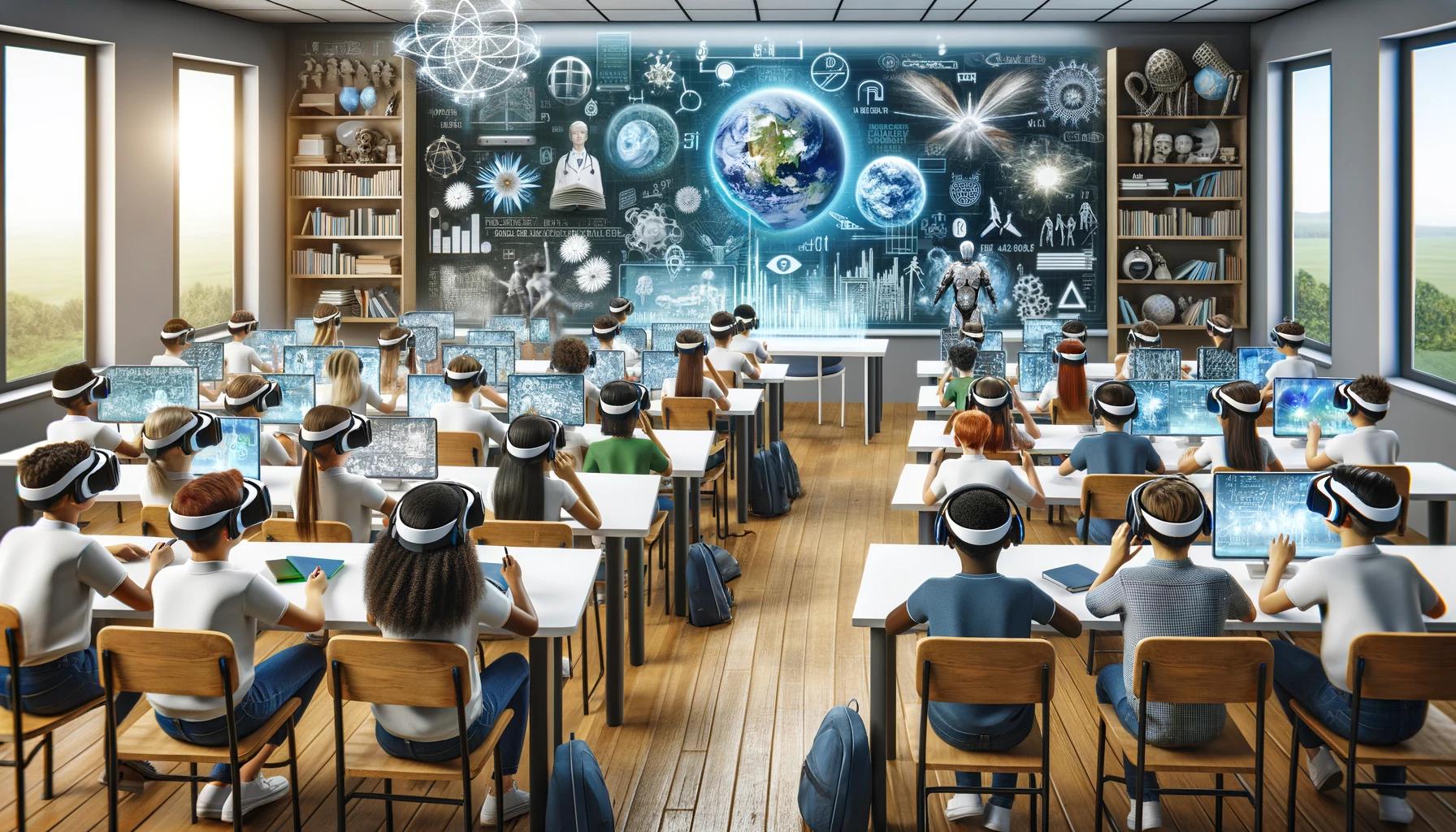The realm of education has continually evolved, embracing new technologies to enhance learning experiences. Virtual Reality (VR) has emerged as a groundbreaking tool in transforming educational paradigms in this digital age. Integrating VR into today’s classrooms is not just a leap into the future of education; it’s a necessary stride toward creating immersive, interactive, and effective learning environments.
The Advent of VR in Education
Virtual Reality has transcended its initial entertainment purposes, finding a significant place in the educational sector. By simulating real-world environments, VR allows students to experience and interact with subject matter in previously impossible ways. This technology has the potential to revolutionize teaching methods, making learning more engaging and accessible.
Understanding VR Technology
At its core, VR is a simulated experience that can be similar to or completely different from the real world. It involves a combination of hardware (such as headsets and controllers) and software, creating immersive digital environments. When integrated into the classroom, this technology can transport students to different eras, places, or situations, providing a richer context to their learning material.
Enhancing Learning Experiences with VR
The use of VR in classrooms goes beyond just visual stimulation; it offers an experiential form of learning. This approach can be particularly beneficial in subjects where practical experience is crucial but difficult to obtain in a traditional classroom setting.
Bringing Abstract Concepts to Life
VR is particularly effective in making abstract concepts tangible. For instance, in a physics class, students can witness the laws of motion in action, manipulating variables to see real-time changes. Similarly, in biology, VR can be used to explore the human body at a cellular level, offering a perspective that textbooks cannot provide.
Bridging the Gap in Distance Learning
VR also plays a crucial role in distance learning. It can create a virtual classroom that feels as real as a physical one, bridging the gap caused by geographical distances. This aspect of VR is especially pertinent in the wake of global events like the COVID-19 pandemic, which necessitated remote learning solutions.
Assessing the Impact of VR on Learning Outcomes
The integration of Virtual Reality (VR) in education has sparked a significant interest in understanding its impact on learning outcomes. This assessment is crucial to justify the investment in VR technology and to guide its effective implementation in classrooms. Several studies have indicated that VR can enhance learning by providing immersive, interactive experiences that traditional teaching methods cannot offer. For example, VR’s ability to visualize complex scientific concepts can lead to a deeper understanding and retention of the subject matter.
However, quantifying the impact of VR on learning outcomes requires a multidimensional approach. Academic performance, measured through tests and assessments, is a primary indicator. But it’s equally important to consider factors like student engagement, motivation, and the development of critical thinking and problem-solving skills. Surveys and interviews with students and teachers can provide valuable insights into these qualitative aspects.
Additionally, long-term studies are necessary to determine whether the benefits of VR learning are sustained over time. This involves tracking students’ progress over several years to see if early exposure to VR-enhanced learning translates into improved academic performance or a greater interest in subjects like science and technology. As VR technology continues to evolve, ongoing research and evaluation will be key to understanding and maximizing its potential in education.
Implementing VR in Classrooms
The implementation of VR in education requires careful planning and consideration of various factors, including technical infrastructure, curriculum integration, and teacher training.
Addressing Technical Requirements
Schools need to invest in VR hardware and software. This includes VR headsets, compatible computers or devices, and educational VR content. While this may initially seem like a significant investment, the long-term benefits of enhancing student engagement and learning outcomes can be substantial.
Curriculum Integration
VR should not be an isolated tool but rather an integral part of the curriculum. This requires educators to redesign lesson plans to incorporate VR experiences that align with learning objectives. The challenge is to use VR to complement traditional teaching methods, not replace them.
Training Educators for VR
For effective integration of VR, teachers must be adequately trained. This involves understanding the technical aspects of VR and learning how to effectively incorporate it into their teaching methodology. Continuous professional development in this area is crucial.
Integrating VR with Other Educational Technologies
The integration of Virtual Reality (VR) with other educational technologies marks a significant leap forward in the realm of modern education. This synergy aims to create a comprehensive, multi-faceted learning environment that harnesses the strengths of various digital tools. For instance, combining VR with Augmented Reality (AR) and Artificial Intelligence (AI) can create a more dynamic and personalized learning experience.
AR can supplement VR by overlaying digital information in the real world, allowing students to interact with both physical and virtual elements simultaneously. This combination can be particularly effective in subjects like history or geography, where students can explore virtual landscapes while referencing real-world maps and data. Conversely, AI can enhance the VR experience by providing adaptive learning paths based on individual student performance and preferences. AI algorithms can analyze student interactions within the VR environment, offering tailored recommendations and challenges to optimize learning outcomes.
Integrating VR with gamification elements also holds significant promise. Gamified learning environments in VR can increase student motivation and engagement, making learning more interactive and fun. This approach is especially effective in keeping students focused and interested in complex or traditionally dry subjects.
Moreover, the use of cloud computing in conjunction with VR enables the storage and sharing of vast amounts of educational content, facilitating collaborative learning experiences. Students can engage in group activities and projects within a virtual space, regardless of their physical location.
However, the key to successful integration lies in seamless interoperability and user-friendly interfaces, ensuring that the transition between different technologies is intuitive for both students and educators. As educational technology continues to evolve, the integration of VR with other digital tools represents a forward-thinking approach to crafting immersive, effective, and engaging learning experiences.
Ethical and Practical Considerations
While VR in education offers numerous benefits, it also raises certain ethical and practical concerns that need addressing.
Ensuring Equal Access
One of the primary concerns is ensuring equal access to VR technology for all students. Educational institutions must work towards minimizing the digital divide, ensuring that students from all backgrounds have the opportunity to benefit from VR learning experiences.
Health and Safety
There are also health and safety considerations, particularly regarding the prolonged use of VR headsets. Schools need to establish guidelines to prevent issues like motion sickness and ensure that the VR content is age-appropriate and educationally relevant.
Navigating the Challenges and Limitations of VR in Education
While Virtual Reality (VR) offers transformative prospects in education, it also presents notable challenges and limitations that educators and institutions must navigate. A primary concern is the cost and accessibility of VR technology. High-quality VR equipment is expensive, and not all educational institutions can afford these tools, leading to a potential digital divide. Additionally, the compatible hardware and software requirement further complicates its widespread adoption.
Another challenge is the potential for VR to cause physical discomfort in some users, such as motion sickness or eye strain. This necessitates the development of guidelines for safe and healthy usage, especially for younger students whose long-term exposure to VR is still a subject of ongoing research.
Moreover, the effectiveness of VR as a teaching tool depends significantly on the quality of the content. There is a need for comprehensive, curriculum-aligned VR content, which is currently limited. Developing such content requires technical expertise and a deep understanding of pedagogical principles.
Furthermore, teachers play a crucial role in integrating VR into the classroom but often face a steep learning curve. Adequate professional development and ongoing support are essential to help educators effectively utilize VR technologies.
Addressing these challenges requires collaborative efforts among educators, technologists, policymakers, and content creators. By working together, the potential of VR in education can be fully realized, ensuring it is an inclusive, effective, and accessible tool for learners.
The Future of VR in Education
The future of VR in education is bright and full of potential. As the technology becomes more advanced and accessible, its integration into classrooms will likely become more widespread. This will change how subjects are taught and students learn, making education a more immersive, interactive, and impactful experience.
Preparing Students for a Digital World
Incorporating VR into education is also about preparing students for a digital world. As they become accustomed to using advanced technologies in their learning, they are better prepared for future workplaces that will increasingly rely on such technologies.
Final Thoughts
Integrating VR into today’s classrooms represents a significant step forward in the evolution of educational methodologies. By creating immersive and interactive learning experiences, VR has the potential to enhance student engagement, improve learning outcomes, and prepare students for a technologically advanced world. The journey of integrating VR into education is just beginning, and its full impact on the educational landscape is yet to be fully realized.

